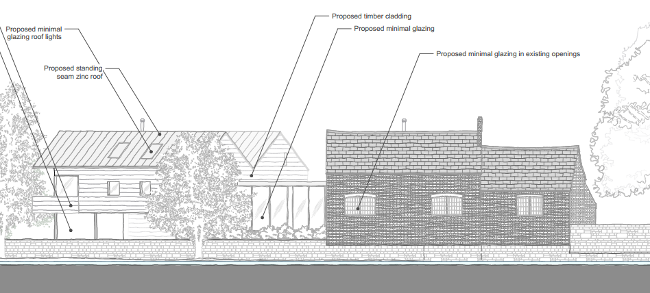Our recent planning appeal success highlights the importance of pragmatism in decision making. The scheme designed by Millar Howard Architects sought the repair, extension and conversion of an existing mill building to facilitate the change of use into a single dwelling house.
We were instructed to help with an appeal, following planning refusal from Stroud District Council for the original application. The key reason for refusal was rooted in the Council’s presumption that the site would be at serious risk in the case of a local flood event, due to its location within Flood Zone 2, and its close proximity to Flood Zone 3.
Following an extensive review of the site, we strongly disagreed with the Council’s conclusion and felt an appeal would be appropriate.
Making the case for a residential conversion in a complex site location:
The site’s location within an Industrial Heritage Conservation Area and outside the settlement limits, as well as the flood risk designations, made for a complex case.
Our pragmatic approach however ensured a robust and persuasive appeal submission, which included:
- Analysis and review of the design and heritage context which identified how the approach to redevelop this historic site would support the future of the mill;
- Successful presentation of evidence to show that the site isn’t isolated despite being located outside the settlement boundary;
- Assessment of demonstrably safe and secure access and evacuation points, along with review of a detailed flood evacuation and management plan for future residents.
Site-specific flood risk assessments for a non-designated heritage asset:
In this particular case, the key issue to overcome when considering flood risk was meeting the set requirement for floor levels close to the flood zone. Due to the complications of converting the Mill building the design was just short of meeting this. Our analysis showed that in order to meet the required floor levels, the entirety of the Mill building would need to be replaced.
Nobody wanted to risk losing the heritage asset, but if planning permission for the conversion wasn’t granted then it was likely the building would continue to fall into disrepair.
We reviewed the options and felt that the proposed scheme was the most positive solution, as it sought to retain as much of the original mill building fabric as possible which would benefit the Conservation Area and the existing non designated heritage asset.
Highlighting the need for pragmatism in decision making, we made a strong case for allowing the conversion:
- There was clearly a very good reason for why the floor levels could not quite be raised to the required level;
- we evidenced how the architect had taken a proactive approach to the conversion, balancing the need to design a safe and practical family dwelling, with flood risk mitigation and resilience, heritage protection, and architectural composition;
- the flood evacuation route had also been shown to be safe.
We are delighted that the Inspector identified the clear positives of this particular case and its unique setting which meant a generic response to flood risk wasn’t appropriate. The wider sustainability benefits to the community outweighed the minor flood risk; the appeal was allowed and planning permission granted.
About us:
We are a knowledgeable and dynamic team of planning consultants and urban designers who are driven to get the right developments in the right locations. If your development scheme would benefit from professional planning consultant input, contact the team see how we can best assist via enquiries@plainview.co.uk.
IMAGE SOURCE: Millar Howard Workshop 2017
